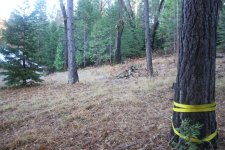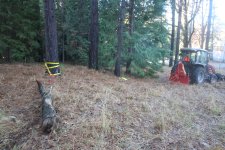Very helpful. I do see how quickly the side roll wants to develop.
Due to my terrain, I was thinking of parking my tractor to the side while pointing downslope, routing my pull cable straight up the hill to a snatch block, then 90 degrees over to the logs to pull them sideways and slightly uphill from the snatch block. But the tractor would be downhill from the logs. After looking at your video, it's obvious to me that if the logs developed a good enough roll during the pull, either before or after releasing the snatch block, they could potentially roll into and hit the tractor. So I will re-look at the area again and figure out how to re-do that.
I don't have a 2nd snatch block. Never considered using two at once before looking at your video. But with my sloping terrain I think I'm going to need one.
Q- if I use a safety rope as suggested above by denchen, are there any tricks to that? I've seen the portable gas-powered capstan winches, and something like that seems ideal for this situation. Unfortunately 95% of my time doing this sort of work is alone with no helper.
That side hill is much steeper than it looks in the video. Before we put a rough grade on it, it was really touchy driving my tractor down it: bearable when things were smooth, but iffy when a wheel hit a stump, rock, or pot-hole. (It will eventually have a much nicer grade on it when we are done.)
There are other tricks besides using a snatch block. In a pinch, I've left my stumps high along the high side of the slope, and run the cable on the uphill side of the stump. I'll winch the log till it's close to the stump, chock the log so it doesn't roll, put slack in the line, then unhook it from behind the stump (since I can't get the log to go around the high side of the stump), and winch some more.
I don't do this trick on a live tree, since the rubbing cable can damage the tree, but a stump or a junk tree is fair game. You can also use a non-self-releasing snatch block: just use a fabric sling to anchor to the tree as I did in the video (perhaps with an old scrap of carpet as padding if it's a particularly valuable tree). You'll have to walk back to manually release the cable from the block, but the non-self-releasing variety are much less expensive than the self-releasing style: Regular snatch blocks sell for about $30, while the self-releasing logging blocks sell for around $300. (Harbor Freight sells a block I linked is rated for 9mm, which is slightly less than 3/8". ost logging winches have cables ranging from 3/8" or 9mm up to 1/2" or about 12mm. Make SURE to get one rated for your cable size and rated higher than your pulling capacity.)
In a pinch, I've seen someone use one of the sliders on their cable for similar purpose: rather than attaching a choker to a log they want to winch out, they attach it to a stump or tree and connect to the slider on the cable. I avoid this, since it can be hard on the cable, but it is do-able, particularly on something like this where you are not taking much of an angle through the slider (the cable is almost in a straight line, unless the log rolls far down hill).



